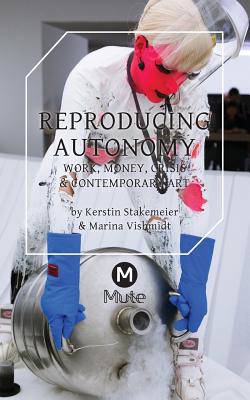
Je cadeautjes zeker op tijd in huis hebben voor de feestdagen? Kom langs in onze winkels en vind het perfecte geschenk!
- Afhalen na 1 uur in een winkel met voorraad
- Gratis thuislevering in België vanaf € 30
- Ruim aanbod met 7 miljoen producten
Je cadeautjes zeker op tijd in huis hebben voor de feestdagen? Kom langs in onze winkels en vind het perfecte geschenk!
- Afhalen na 1 uur in een winkel met voorraad
- Gratis thuislevering in België vanaf € 30
- Ruim aanbod met 7 miljoen producten
Zoeken
Reproducing Autonomy
Work, Money, Crisis and Contemporary Art
Kerstin Stakemeier, Marina Vishmidt
Paperback | Engels
€ 30,95
+ 61 punten
Omschrijving
Progress in autonomy cannot be - nor historically has it ever been - measured in quantitative units. Rather, the need for autonomy is repositioned in relation to society's political, economic, and cultural developments on an ongoing basis. What do we mean when we speak of 'autonomy' and 'reproduction' in the field of contemporary art? What kind of objects do these terms encompass, what are their histories, and what internal logical relations can we identify between these concepts? How do they operate in a philosophical discourse about art and in political theory and practice? In this book, Marina Vishmidt and Kerstin Stakemeier analyse 'autonomy' and then 'reproduction', in the understanding that this method of categorical isolation must be overcome if we are to reach towards the relationship of the two terms. These three essays establish a new framework to locate notions of artistic autonomy and autonomies of art. The texts not only offer an entrance into thinking about the role that autonomy has occupied in modern European intellectual history; they also put forward an original thesis.
Specificaties
Betrokkenen
- Auteur(s):
- Uitgeverij:
Inhoud
- Aantal bladzijden:
- 108
- Taal:
- Engels
Eigenschappen
- Productcode (EAN):
- 9781906496999
- Verschijningsdatum:
- 6/05/2016
- Uitvoering:
- Paperback
- Formaat:
- Trade paperback (VS)
- Afmetingen:
- 127 mm x 203 mm
- Gewicht:
- 122 g

Alleen bij Standaard Boekhandel
+ 61 punten op je klantenkaart van Standaard Boekhandel
Beoordelingen
We publiceren alleen reviews die voldoen aan de voorwaarden voor reviews. Bekijk onze voorwaarden voor reviews.









